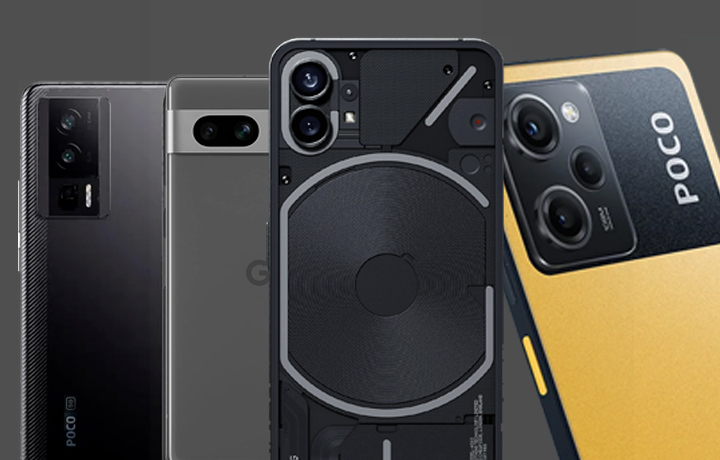Best 2023 Budget Smartphones for Photography
Xiaomi Redmi Note 12 vs. Pro vs. Pro Plus:
Camera phones on a budget should also check out Xiaomi’s latest trio of Redmi smartphones, covering a range of budgets – the Redmi Note 12, 12 Pro, and 12 Pro Plus. Those Pro models dish up a more powerful Dimensity chipset, faster battery charging, stereo speakers, and some other benefits for a bit of extra cash. And to make things even more complicated, Xiaomi has packed completely different camera hardware into all three of these Redmi devices.
You’ve got a 48-megapixel (possibly an Omnivision) effort on the Redmi Note 12 that’s upgraded to a 50-megapixel Sony IMX 766 with Optical Image Stabilization on the Pro. And then, that’s boosted again to a 200-megapixel Samsung HPX effort, again with OIS on the Pro Plus. You essentially get the same camera app on all three, packed with all the same features, including the good old reliable AI mode, which can determine what you’re trying to snap and then tweak the settings on your behalf. You’ve got filters to play with, timers, and you can change up the aspect ratio.
Regarding photo quality side-by-side samples on all three do the job in a well-lit scenario. Even the regular Redmi Note 12 doesn’t struggle too much with HDR-style situations. The Redmi Note 12 Pro, with that dependable IMX 766, is definitely a step up, though. And then, when it comes to low-light scenarios, that’s where the Redmi Note 12 Pro Plus really steps in with that 200-megapixel sensor.
That pixel-binning technology really brightens up your snaps, even when light is scarce. So, you get impressive levels of detail and total accuracy. If you find yourself out in the evenings a lot, you’ll definitely want to consider that Pro Plus. And of course, the fact that you’ve got image stabilization on the Pro and Pro Plus really helps out with those low-light shots as well.
You’ve got all the usual bonus camera modes packed on all three of these phones, including portrait mode, complete with customizable bokeh action on the Pro and Pro Plus. If we jump into the more section, the Redmi Note 12 5G does have fewer options than the Pro versions, but you’re only losing a couple of bits like the Vlog mode and the long exposure mode.
As you don’t have the optical image stabilization, if you like to shoot lots of videos on your smartphone, you might want to look at the Pro models. They top off at 4K resolution at 30 FPS. You’ve also got a 1080p at 60 FPS option, whereas the regular Redmi Note 12 5G tops off at 1080P 30 FPS.
The regular Redmi Note 12 is fine for shooting simple, short, shareable clips, as long as the lighting isn’t poor. But it’s certainly the Pro models that do really, really well, producing some nice-looking video, especially for this price point. Respectable image stabilization, clear audio capture – the works.
As for the other two lenses, well, they’re identical on all three of these smartphones. You’ve got a basic 8-megapixel ultra-wide-angle shooter, which is good if you just want to fit a bit more into the frame, and a bog-standard 2-megapixel macro lens, which is frankly pointless.
And as for those front-facing selfie cams, well, there is slightly different tech again. It’s a 13-megapixel shooter on the Redmi Note 12 that gets upgraded to a 16-megapixel here on the Pro and Pro Plus. But all three do a pretty decent job, even when the lighting is a bit dim or when you’ve got a really bright background to contend with.
OnePlus Nord 2T:
Another favorite of mine is the OnePlus Nord 2T, which, once again, supports a slick AMOLED screen, smooth everyday performance, and dependable battery life. Slapped on that is yet another 50-megapixel Sony IMX 766 camera sensor. And it’s once again a good all-rounder in most circumstances. Most of my test photos look pretty natural with vibrant colors when appropriate and enough sharp details. They look good on a proper big telly screen.
The focus is fast to react and rarely messes up, even when the subject is in motion. At night, you still get attractive-looking pics from that IMX 766 sensor, even without employing OnePlus’s dedicated night modes. The improved Domensity processes help in dim conditions. Things have to be really dim before you finally get some grain and ugly stuff creeping into your shots.
Indoor snaps tend to come out quite warm, but again, with impressive detail considering they were captured by a mid-range mobile. And by the way, you are very welcome for this horrific nightmare fuel, which comes courtesy of that mental Google event. All I can say is, thank God I was hammered by the time I shot these photos.
Now, if anything in this camera setup needed upgrading, it’s definitely that 8-megapixel ultra-wide-angle snapper. This is okay-ish for outdoor snaps with good lighting, although colors do look a bit wonky, and the results are pretty dreadful once you move indoors If you’re trying to snap stuff at night.
You can also shoot up to 4K resolution video on the OnePlus Nord 2T. This again does the job for your home movies, offering sharp detail, accurate colors more often than not, and strong enough stabilization so your footage isn’t reduced to a shaky mess whenever you move.
In low light, things don’t immediately look terrible, and the audio capture was good enough to clearly pick up and emphasize vocals, both in front of and behind the camera. And finally, up front, you’ve got a 32-megapixel IMX 615 sensor for shooting all those lovely selfies. This works fine in good light, but in more ambient conditions, you will need a steady hand to avoid blurry photos. But considering the price and what the Nord 2T offers for you, I think it’s another decent option. Go Next for more…
- Check out the latest prices here:
- OnePlus Nord 2T
- Xiaomi Redmi Note 12
- Xiaomi Redmi Note 12 Pro
- Xiaomi Redmi Note 12 Pro Plus






